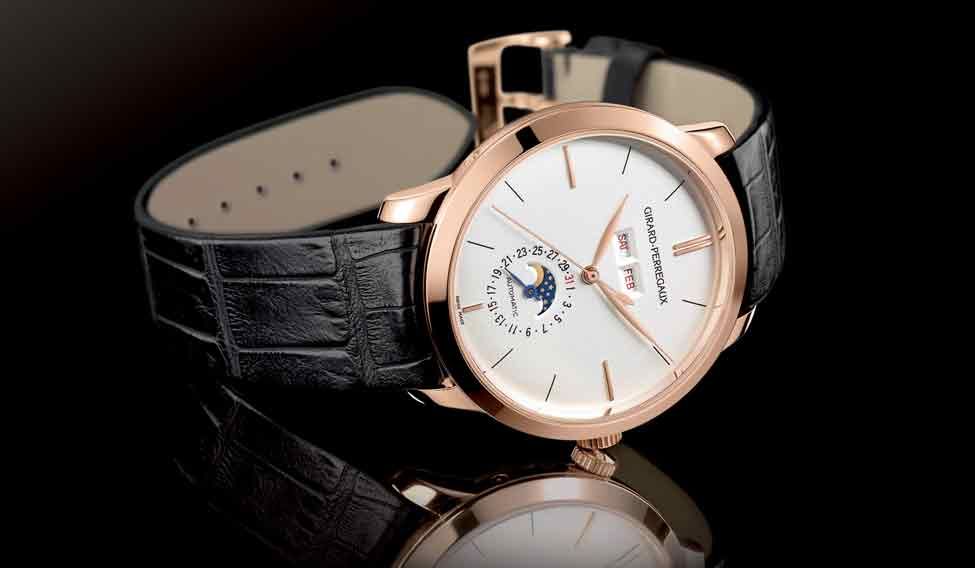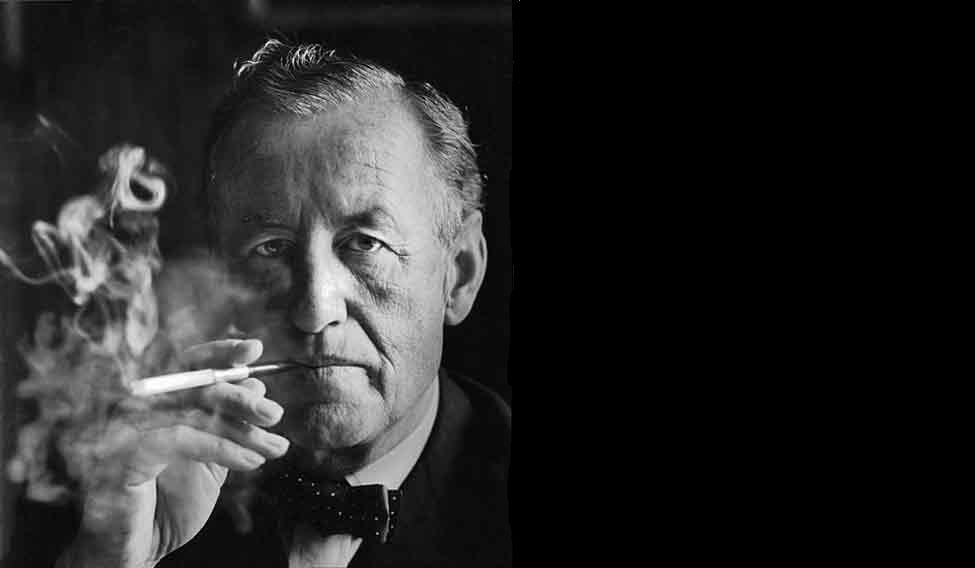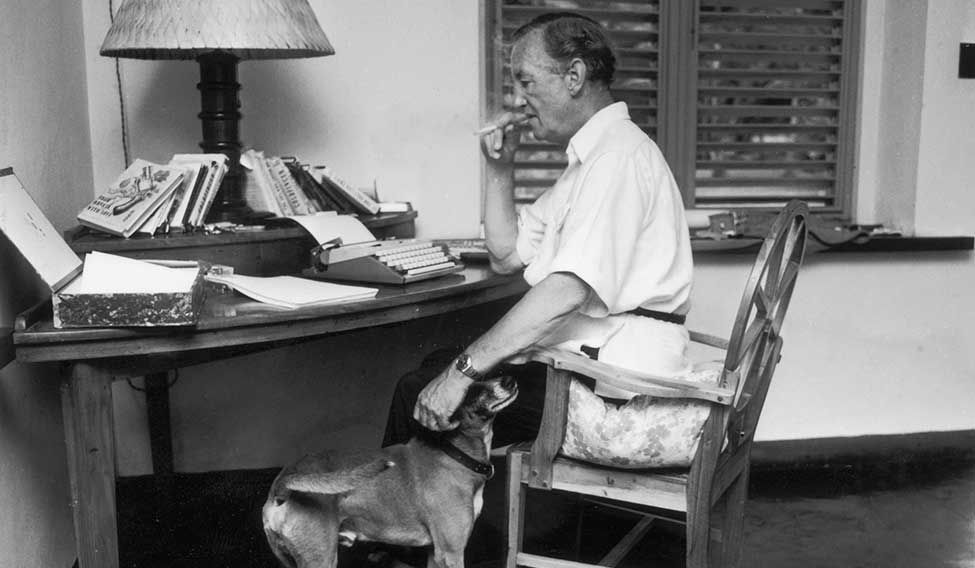Did Ian Fleming, the creator of James Bond, have a particular wristwatch in mind when writing the original 007 stories? Could it be that Fleming himself wore the first James Bond timepiece?
Only one brand is specifically named as that secret agent’s watch in Fleming’s original 14 Bond editions: Rolex. The greatest detail comes in his eleventh book, On Her Majesty’s Secret Service, published in 1963. Here we read of the “big luminous numerals” that Bond sees when taking a lazy midnight glance at his chronometer, “a heavy Rolex Oyster Perpetual on an expanding metal bracelet.” The watch is a Rolex Explorer I.
And not just any Rolex Explorer I. My research convinces me that it was Fleming’s own stainless-steel wristwatch, model 1016 with a black dial on a 7206 bracelet, case number 596851. Fleming’s stepdaughter, Fionn Morgan, believes it is the first and only Rolex he ever owned. After her stepfather passed away on August 12, 1964, the watch was locked in a bank vault. There it stayed until the death of her mother—his widow, Ann—in 1981. That was when, following almost 20 years in isolation, it once again saw the light of day.
“Spookily, it was still going,” Morgan said to me, recalling the day she first picked it up. “I am told that this happens with Oyster Perpetuals; your hand sets them off.” To her the watch was intensely personal, a family heirloom left by a man she loved as if her own blood-relation father. So she did what many of us would do. She gave it to her son-in-law, to wear daily as a touchstone with her past.
That’s how it went until preparations began for the “Ian Fleming Centenary,” a year-plus celebration associated with the author’s 100th birthday on May 28, 2008. In particular, Britain’s Imperial War Museum (IWM) was planning a special 45-week exhibition titled, “For Your Eyes Only: Ian Fleming and James Bond.” Mary Gibson, Fionn Morgan’s daughter, loaned for show the Ian Fleming watch that her husband had been wearing. Along with other Fleming artifacts and props from James Bond movies, the watch was on display at the museum in London until March 1, 2009.
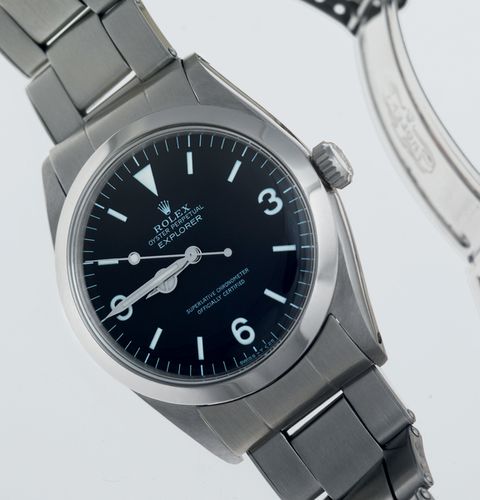 Ian Fleming’s Rolex Explorer I watch, which the author used as the model for James Bond’s watch in On Her Majesty’s Secret Service | Imperial War Museum
Ian Fleming’s Rolex Explorer I watch, which the author used as the model for James Bond’s watch in On Her Majesty’s Secret Service | Imperial War Museum
The IWM exhibit asked a question often debated by Fleming biographers: How much of James Bond was Ian Fleming? Evidence abounds that Fleming steeped this fictional spy with his most personal tastes and habits. The 007 clothing choices, hatred of tea, and number of cigarettes smoked in a day all parallel aspects of Fleming’s own life.
Product placements abound in his books. Familiar brands hook us to Bond’s world through the reality of what we already know and accept. Bond’s creator was thoughtful in the use of these. Thus there are obvious distinctions between references made to things he had simply researched to fill in gaps, and those he experienced personally.
In total, there are approximately 100 references to James Bond wearing a watch in the Fleming novels and short-story collections published between 1953 and 1966 (the last two were posthumous). Two-thirds of these tell readers nothing more than the time of day. This is particularly true in earlier novels such as Moonraker, Diamonds Are Forever, and Goldfinger, where Agent 007 mostly just looks or glances at his watch, on average nine to 10 times per story.
Function and design details come slowly. We hear Bond’s watch “tick” for the first time in 1955. In 1957, we are told that, although he otherwise sleeps naked, Bond wears a watch to bed. Fleming used the word “glass” when referring to its crystal in From Russia, with Love. For Doctor No a dial is not just “luminous,” but blazingly so! In 1960, 007’s eyes follow “the gleaming minute-hand” creeping past its time markers.
The Ian Fleming thrillers feature multiple James Bond watches. Bond loses his watch during the Casino Royale torture, has another watch shot apart on his wrist in From Russia, with Love, destroys a Rolex while using it as a “knuckle-duster” in On Her Majesty’s Secret Service, and is unlikely to have returned for whatever timepiece he left behind when Tiger Tanaka gives him a “cheap Japanese wristwatch” for his final pursuit of recurring arch-villain Blofeld in You Only Live Twice.
Fleming, too, had many watches. Photographs from the 1950s show him variously wearing a half-dozen-or-so nondescript wristwatches, mostly on straps. None stands out. This parallels the attitude of his character through the period as well. I don’t suggest that Fleming treated his own watches as disposable (as his alter-ego certainly does). But Fleming heirs told me last summer that his Explorer I is the only wristwatch known to have survived him.
Some Bond aficionados insist that Rolex is established as the definitive “James Bond watch” in Live and Let Die (1954). I don’t think so. When Fleming settled on a brand, he tended to either repeat it or clearly label its replacement. We don’t simply read about locks, we read about Yale locks, again and again, in multiple novels. James Bond drives a Bentley or an Aston Martin or a Thunderbird, a specific car, as opposed to any car we might imagine.
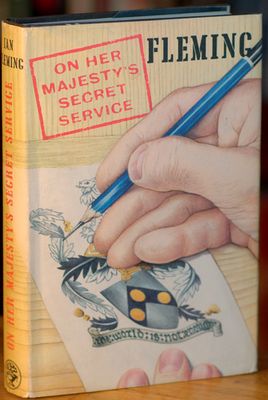 A first edition of Fleming’s On Her
Majesty’s Secret Service, which contains seven references to James Bond’s Rolex Oyster Perpetual | www.jamesbondwatches.com
A first edition of Fleming’s On Her
Majesty’s Secret Service, which contains seven references to James Bond’s Rolex Oyster Perpetual | www.jamesbondwatches.com
That’s not the case with the 1954 Rolex. After Live and Let Die, almost a decade passed before Fleming gave Bond another Rolex. In the meantime, Fleming hadn’t forgotten the brand, since “a solid gold Rolex Oyster Perpetual Chronometer on a flexible gold bracelet” features prominently as a bad guy’s watch seven novels later, in Thunderball. (This Rolex becomes a “James Bond watch” of sorts, since Agent 007 puts it on his own wrist after removing it from the villain’s dead body.)
Secondly, the Live and Let Die Rolex is a divers’ watch; hardly what men wore daily in the 1950s. We know how Bond’s watch had to perform here, because he “looked at the Rolex on his wrist” while underwater. He was at the close of a 300-yard dive in Jamaican waters, on a well-prepared mission to place mines on a smuggling vessel, moored at an anchorage of about 30 feet. His agency quartermaster, Q Branch, has supplied him with a wetsuit and other special-purpose equipment for the assignment. It’s likely that Q had provided this particular watch as well, and that Bond did not choose the Live and Let Die Rolex for himself. (Years later, in On Her Majesty’s Secret Service, we learn that Q Branch actually keeps an off-the-shelf inventory of Rolex wristwatches, or at least came to do so by 1963.) For Live and Let Die, I think the plot simply called for 007 to check his watch in mid-swim in order to build tension at a key point in the exposition. As a diver himself, Fleming knew that a typical wristwatch was unsuitable; he needed to cite a specific brand to make that awareness clear. Being an accomplished journalist, he would have researched options.
Finally, the lack of any further specifics on this Rolex, and no reference whatsoever to the brand in his next eight books, classify it as a watch Fleming researched rather than experienced. Most likely, he chose Rolex because of its advertising, which emphasized waterproof case integrity.
This is more than speculation. In a letter he wrote four years after completing his Live and Let Die manuscript, Fleming made it clear that Rolex was not at that time James Bond’s choice for a timekeeper. This came in response to written criticism from an astute reader. Following are excerpts from each side of their correspondence, provided to me by Fleming’s stepdaughter.
On April 25, 1958, a reader complained about the performance of Agent 007’s watch in Doctor No. Specifically, “Bond glanced at his watch. It had stopped at three o’clock.” Stopped! This sentence made the reader “extremely surprised and perturbed.” He considered it “a very serious matter which should at once be drawn to the attention of M [Bond’s boss’s codename],” suggesting this field failure “be made the subject of an Official Inquiry.” The reader proposed a solution. In the future, Bond should be issued a “Rolex Oyster Perpetual, which is completely waterproof and does not require winding,” and, if anything, “keeps even better time after immersion.”
Fleming acknowledged the complaint and made his reply. “I have discussed this with [James Bond] and he points out that the Rolex Perpetual weighs about six ounces and would appreciably slow up the use of his left hand in combat.”
Then, this: “His practice, in fact, is to use fairly cheap, expendable wrist watches on expanding metal bracelets which can be slipped forward over the thumb and used in the form of a knuckle-duster, either on the outside or the inside of the hand.” If Bond’s personal watch was “cheap” and “expendable” up until 1958, it was never a Rolex.
No particular Oyster Perpetual model was cited in either letter. Fleming simply repeated the “Rolex Oyster Perpetual” reference in the reader’s letter. He did, however, come up with a weight for the watch and considered its feel. But this event did not yet set the wheels in motion for his own purchase of the Explorer I. If the 007 watch had moved from a researched to an experienced item, we’d see a change in his writing. The next three books (written after the exchange of letters) feature just over a dozen notations on the watch Bond is wearing. All remain true to form, never going beyond a “gleaming minute-hand” or a luminous dial notation.
Everything changes with On Her Majesty’s Secret Service, written in 1962. Thirteen percent of all James Bond watch references are in this one novel, more than in any other Fleming thriller. He cited the Rolex brand in seven places. As Bond expert and author Kingsley Amis generally observed, Fleming wrote “with an energy that shows [when] he’s dealing with something personally important to him.” What was that?
I’m convinced that it was the deal struck with Eon Productions in 1961 to make five James Bond movies. The first, Dr. No, began filming in Jamaica during the early months of 1962 — the same time Ian Fleming was there, writing On Her Majesty’s Secret Service. We know that cross-pollination resulted, because the virtually unknown actress who played the female lead in Dr. No is referred to as “Ursula Andress, the film star” in the novel On Her Majesty’s Secret Service.
Sean Connery, as Bond in Dr. No, wore a Submariner. Whoever made that happen, the only Fleming book then existing to specify a Rolex was Live and Let Die. It’s hard to imagine that Ian Fleming would have let the last detail of Bond’s Rolex model be determined by someone else. Neither would he have forgotten the 1958 letter that first recommended Rolex to him. As 007 followers know, it was another reader’s letter, from gun expert Geoffrey Boothroyd, which persuaded Fleming to have James Bond give up his signature Beretta pistol in favour of a Walther PPK.

By 1962 when filming began on Dr. No, Ian Fleming was becoming an icon in his own right through his books, increasing public attention (good and bad), and sophisticated self-promotion. At the same time, “James Bond” was taking on a life of his own, beyond the control of his creator. All of this affected Fleming. Lines were blurring as he sought to identify himself more closely with his character, to live as 007 would live, to play the part. Biographers have written about this. His wife, Ann, noted that no one had “grasped the extent of Ian’s desire to be his alter ego.”
Ian Fleming acquired his Rolex Explorer I sometime between the summer of 1961 and spring of 1962. It’s this chronometer that changed his writing about Rolex and James Bond from researched to experienced.
In contrast to the sunny beaches where movie work was underway in Jamaica, the main action of On Her Majesty’s Secret Service takes place on a snow-covered mountain. If you were going to pick a watch for such an adventure, what better choice than a Rolex Explorer, the watch that had famously conquered Mount Everest in 1953?
Bond’s watch is described as having “numerals,” as opposed to undefined markers. Fleming’s own Explorer I had luminous 3-, 6-, and 9-o’clock indicators. “Bond surveyed his weapons. They were only his hands and feet, his Gillette razor and his wristwatch, a heavy Rolex Oyster Perpetual on an expanding metal bracelet. Used properly, these could be turned into most effective knuckle-dusters.” But this doesn’t mean the “expanding-link” option offered by Rolex at that time. Fleming had established in Thunderball that “flexible” was a bracelet with springs in its links. Fleming’s personal Explorer is fitted with the original 7206 bracelet; it has fixed links and a deployant clasp. Laymen describe this as “expanding” to open. Finally, Fleming specifies the 007 watch as new in Chapter 23. The Fleming Rolex case number 596851 suggests it, too, would have been a relatively new model 1016 that the author was wearing as he wrote this novel.
For the publication of On Her Majesty’s Secret Service, Fleming commissioned an oil portrait of himself, painted in 1962 by longtime friend Charles Amherst Villiers. It appears as a frontispiece in a special edition of 250 numbered copies of the book. I confirmed last summer that it captures Ian Fleming wearing his Explorer I, its dial reading 12:05.
So why stop at calling it a “Rolex Oyster Perpetual” in the novel when the name “Explorer” was so evident on the face of Fleming’s own watch — the watch he used as referent while typing? Why not note the material as stainless steel, indulging his penchant for adding detail after detail? Of all Rolex models at the time, this one was identified with unwavering performance under the harshest conditions, an ideal watch to advance his characterisation of James Bond. Why didn’t he identify it as an Explorer?
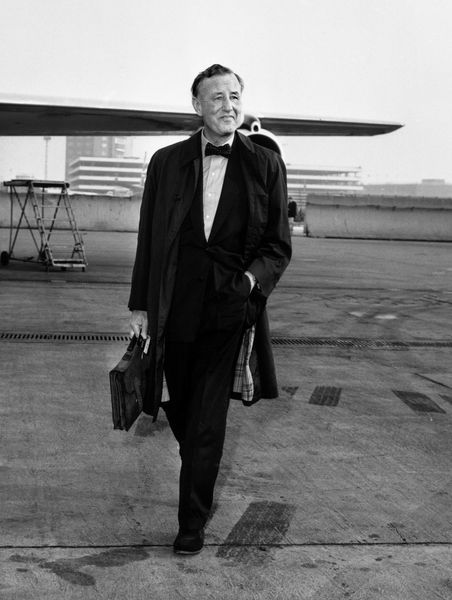 Ian Fleming on the tarnac in January 1964 wearing his Rolex Explorer I
Ian Fleming on the tarnac in January 1964 wearing his Rolex Explorer I
Because he wanted to give a wink and a nod to that reader who’d first recommended Rolex to him almost four years earlier. I think that was more important to Fleming. In this case, going no further than calling the watch a “Rolex Oyster Perpetual” was, in fact, quite specific to him, more personal. His 1958 letter became notes for his 1963 novel (he hated to waste good material): On page 177 we see, “the Rolex transferred to [Bond’s] right, the bracelet clasped in the palm of his hand and round the fingers so that the face of the watch lay across his middle knuckles.”
Unlike the Live and Let Die watch, there is no question that this piece is James Bond’s choice. He is concerned about its out-of-pocket cost. During the debriefing with M, in Chapter 20 of On Her Majesty’s Secret Service, “Bond lifted his left wrist” to check the time. “Remembered that he no longer had a watch. That would certainly be allowed on expenses. He would get another one as soon as the shops opened after Boxing Day. Another Rolex? Probably. They were on the heavy side, but they worked. And at least you could see the time in the dark with those big phosphorous numerals.” We see Fleming’s Explorer I on Bond for the last time (ever) on page 241, when 007 “glanced at the new Rolex on his wrist.” Yet we still learn something: James Bond may continue wearing a watch after it becomes “old,” as his friend Felix Leiter once observed; but when it’s time for replacement, he chooses new.
This first specific wristwatch chosen for Bond not only remains in current production as the model 114270, but its overall appearance remains true to the 1016 that Ian Fleming put on James Bond’s wrist in 1962. So what would it really mean to go “back to the original Fleming” and put Bond in an 114270 for 2009? I think it would symbolise a more discreet operative, more subtly able to transition from casino to combat — every bit as tough, but without advertising his Navy service with a watch that sticks out from his shirt cuff.
Just prior to display of Fleming’s Rolex Explorer I at the Imperial War Museum, it was virtually all-original. On February 13, 2008, a Rolex service center had its first opportunity to make an assessment. The movement had rust and had been damaged by water contamination. Its bezel, and caseback were scratched, its 5- and 11-o’clock lugs were “marked.” The crown was broken at the stem. The bracelet was strained, “clasp cracking at pin of blades.”
I was told before the museum opening that someone raised concerns about “protecting” visitors from the radioactive material used to make its now-half-century-old dial luminescent. Stanchions and ropes were discussed as a way to keep the public at a safe distance. In the end, it was decided to replace the original dial that had illuminated so much of one great James Bond story.
Still, this chronometer continues to serve as a tangible reminder that there is no James Bond without Ian Fleming. In this most personal way, James Bond was Ian Fleming. And his watch, the Rolex Explorer I, is the first, authentic James Bond watch.
Dell Deaton is an expert on Ian Fleming and James Bond, founder of jamesbondwatches.com.
Rolex: James Bond’s Secret Weapon

Illustrator John McLusky was the first to provide a visual interpretation of what he thought Ian Fleming had intended for the 007 Rolex in On Her Majesty’s Secret Service. McLusky helped create a “James Bond” comic strip, adapted from Ian Fleming’s novels and short stories, for Britain’s Daily Express from 1958 to 1966. The Bond Rolex appears in installment 144 of the series in 1964. Unfortunately, these drawings came after Fleming’s death, so McLusky did not have the author’s input regarding wristwatch specifics.

Still, it’s interesting that McLusky depicted the watch with luminescent numbers at 6, 9, and 12, along with a signature Rolex date magnifier. The next day’s comic strip shows Bond dispatching one of the henchmen working for his archenemy Blofeld, first with a chop to the neck. Then, we read: “Bond using the wrist watch as a knuckle-duster, gave him the coup de grace.”

The watch is referred to by brand name as “the shattered Rolex” in installment 169 three weeks later, where Bond once again prepares to use it as a “knuckle-duster.”
Bad Guys, Good Watches
Ian Fleming was familiar with a number of high-end watches and on occasion used them to flesh out the characters that crossed 007’s path.
There’s Jed Midnight, a member of a crime syndicate in Goldfinger: “The complicated gold watch on his wrist must have weighed nearly half a pound.”
Hugo Drax, known for precision in every detail, wears “a plain gold Patek Philippe watch” in Moonraker.
A “bulky gold wristwatch on a well-used brown crocodile strap” is the choice of Donovan “Red” Grant, chief executioner for the Cold War USSR in From Russia, with Love. “It was a Girard-Perregaux model designed for people who like gadgets, and it had a sweep second-hand and two little windows in the face to tell the day of the month, and the month, and the phase of the moon.”
Giuseppe Petacchi in Thunderball, a pilot for the underworld consortium known as SPECTRE (“Special Executive for Counterintelligence, Terrorism, Revenge, and Extortion”) has “a passion for owning things — flashy, exciting, expensive things.” His watch is “a solid gold Rolex Oyster Perpetual Chronometer on a flexible gold bracelet.” Curiously, the watch worn by Tiffany Case in Diamonds Are Forever stands out uniquely as a women’s timepiece identified by name. It’s a “small square Cartier” on a black strap. Some years after this novel, Ian Fleming himself actually gave a Cartier wristwatch to his Jamaican confidante Blanche Blackwell, as thanks for her sharing with him the real-life events on which he later based his short story, “Quantum of Solace.”




